Please note: this page contains affiliate links
Betta fish need plants to replicate their natural habitat and to provide hiding and resting areas. Despite their fighter fish name, betta fish are actually relatively shy and skittish under normal circumstances. Plants are especially important in divided tanks and community tanks to provide safety and reduce stress.
Below you will find the best plants for betta fish with both fake and live choices to choose from. Plants also make your tank look beautiful and more realistic to that of a normal ecosystem.
Fake Betta Fish Plants
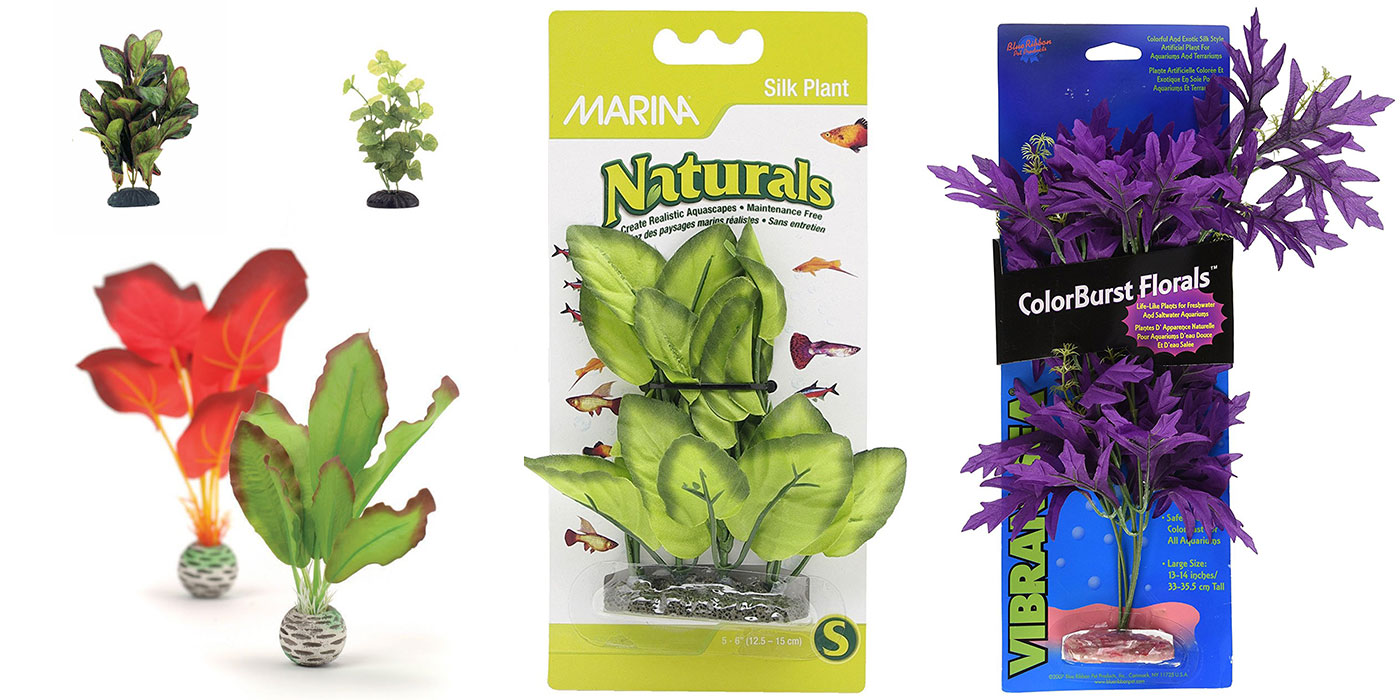
Beginners often start with fake plants for their betta fish and to make their tank more visually appealing. That’s perfectly fine even for those who don’t ever wish to care for live plants. It’s very, very important that you choose silk plants over plastic plants though unless the plastic is soft and not jagged. Betta fish have delicate fins which can be easily torn on hard plastic edges.
Silk plants also move and perform most similarly to live plants. They are not at risk of rotting, dying, being eaten by tank mates, carrying disease, and are relatively inexpensive. They do however come without the helpful properties of live plants like oxygenating the water and absorbing betta waste.
There are many options and colors of fake plastic and silk plants, but you should add one’s that mimic the live plant recommendations below. A healthy mix of foreground, mid-ground, background, and even floating silk plants are ideal to recreate a natural betta fish ecosystem. Just don’t over do it and make it hard for your betta to reach the surface for feeding and air.
Fake Plant Care
Before adding a new plastic or silk plant to your betta’s tank, always rinse it in hot water to remove any bacteria, dust and debris. Fake plants can also attract algae and feces may collect on leaves and in crevices. Every time you clean your tank, you should also clean and rinse (hot water) your fake plants and other decorations thoroughly.
Live Betta Fish Plants
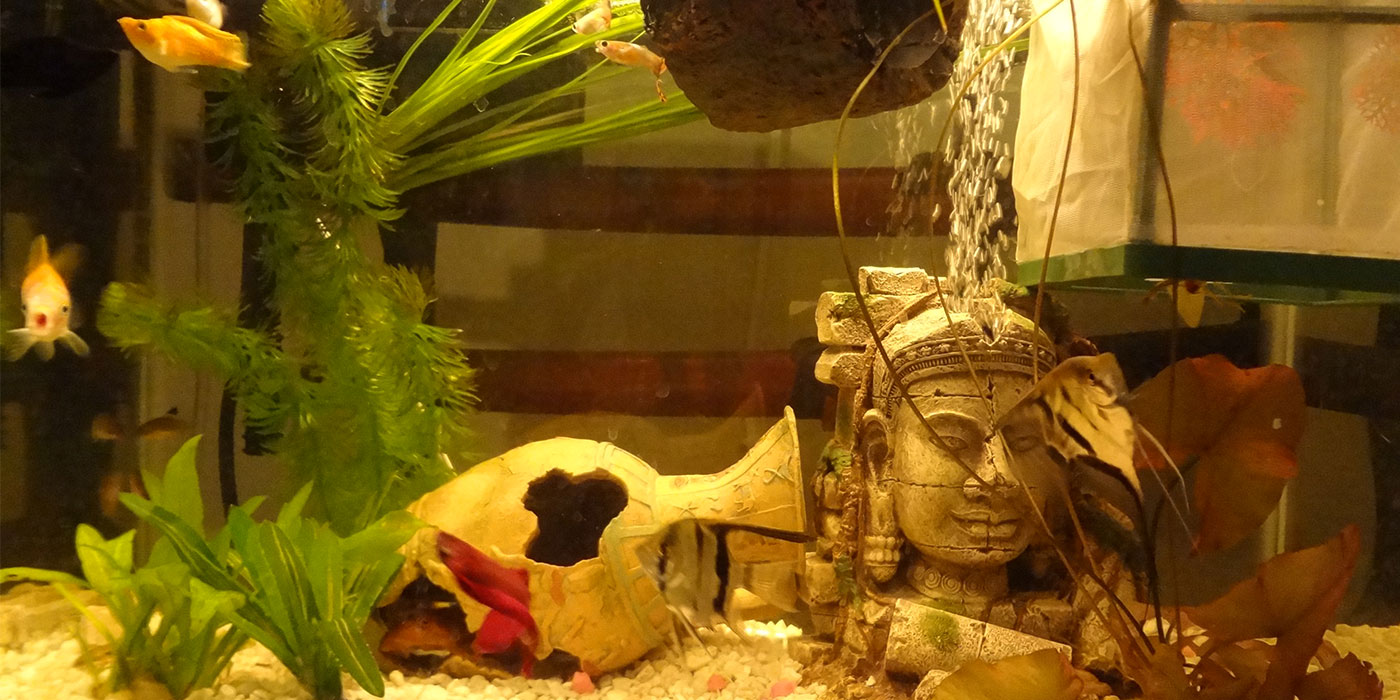
Unlike fake plants, live plants have varying levels of required maintenance and can provide lots of additional benefits. Live plants for betta fish tanks can add oxygen to the water and reduce harmful ammonia and nitrate levels which can stress or even kill your betta. Like fake plants, they provide hiding and resting spaces and can keep betta fish from getting bored. Boredom can lead to fin biting and other unwanted side effects.
Live plants may also be cheaper over time if they are properly cared for and propagated. More advanced aquarists may even have a separate tank composed of only living plants to help support their community tanks or simply for beautiful aquascape viewing. Propagated plants can be moved around the tank or into other tanks to start additional growths.
Important: When shopping for live plants in person you should always inspect them carefully for rotting, discolorations and overall health. Don’t buy any plants that look like they are dying. Also be careful when purchasing plants for your betta that are inside community tanks (not recommended). These live plants can and often do carry common aquatic diseases that can cause betta sickness or death. They must be quarantined prior to introduction. For single tubed and packaged live plants (sold online or in stores), follow the instructions on their label.
10 Best Betta Fish Plants
All of the options below are inexpensive and ideal for a betta fish ecosystem and can live in similar temperature and water parameters (e.g. pH). Some require little to no maintenance, while others require moderate care, light and feeding.
Certain species of plants, like the Amazon Sword or Hornwort below can grow very rapidly. Always monitor live plant growth to allow for ample swimming and feeding space, and the ability to surface for oxygen without excessive effort.
1. Amazon Sword
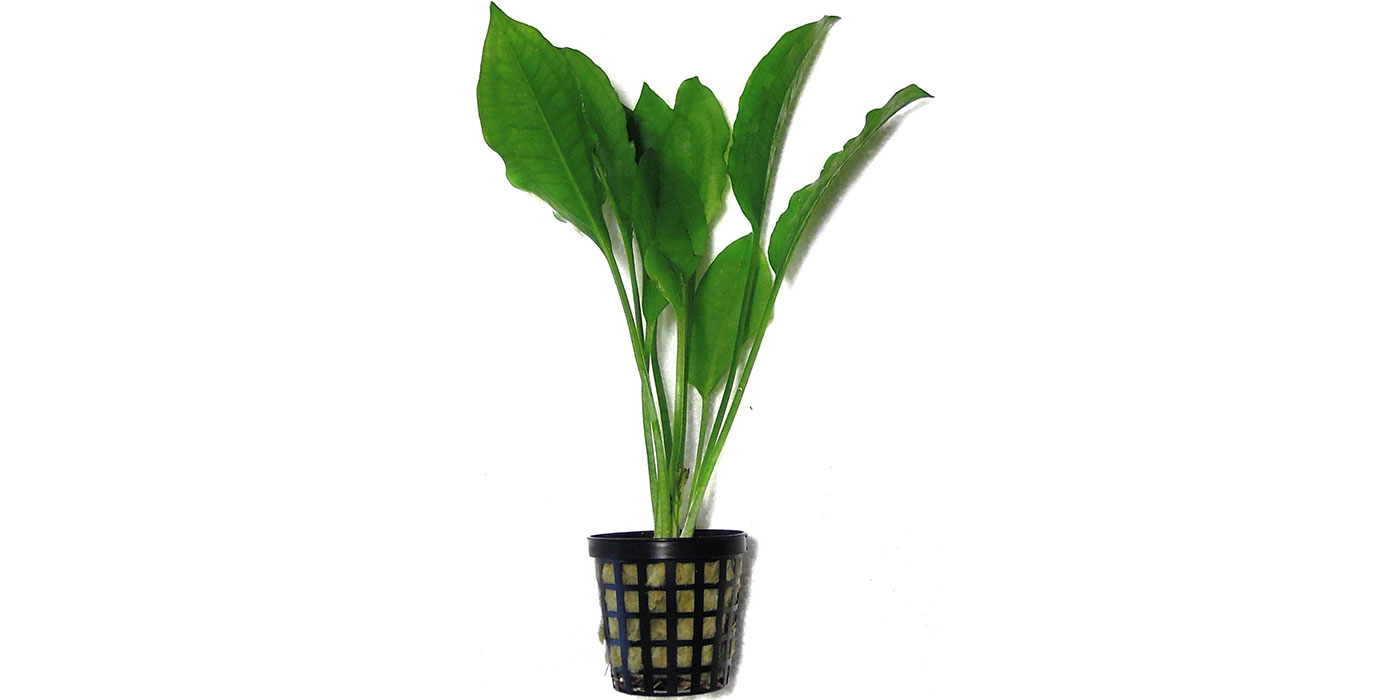
Scientific name: Echinodorus amazonicus
Placement: Background
The Amazon Sword is easy to grow and maintain. They are considered a staple in many betta fish tanks and aquariums because of their beauty and hardiness. Although there are dozens of varieties of Amazon Sword plants, in most pet stores they are all sold under the same name.
Amazon Swords are incredibly easy to care for and do best in larger tanks, where they will have more room to grow. The plant is fine for smaller tanks, but will need trimming to prevent it from taking over the tank. They need limited amounts of light.
If left alone, Amazon Swords can grow to be about 12 inches tall, but can grow to twice that height under the proper conditions. Soil substrate (3-4 inches) is recommended, however it is possible to bury the roots underneath aquarium gravel.
2. Anacharis
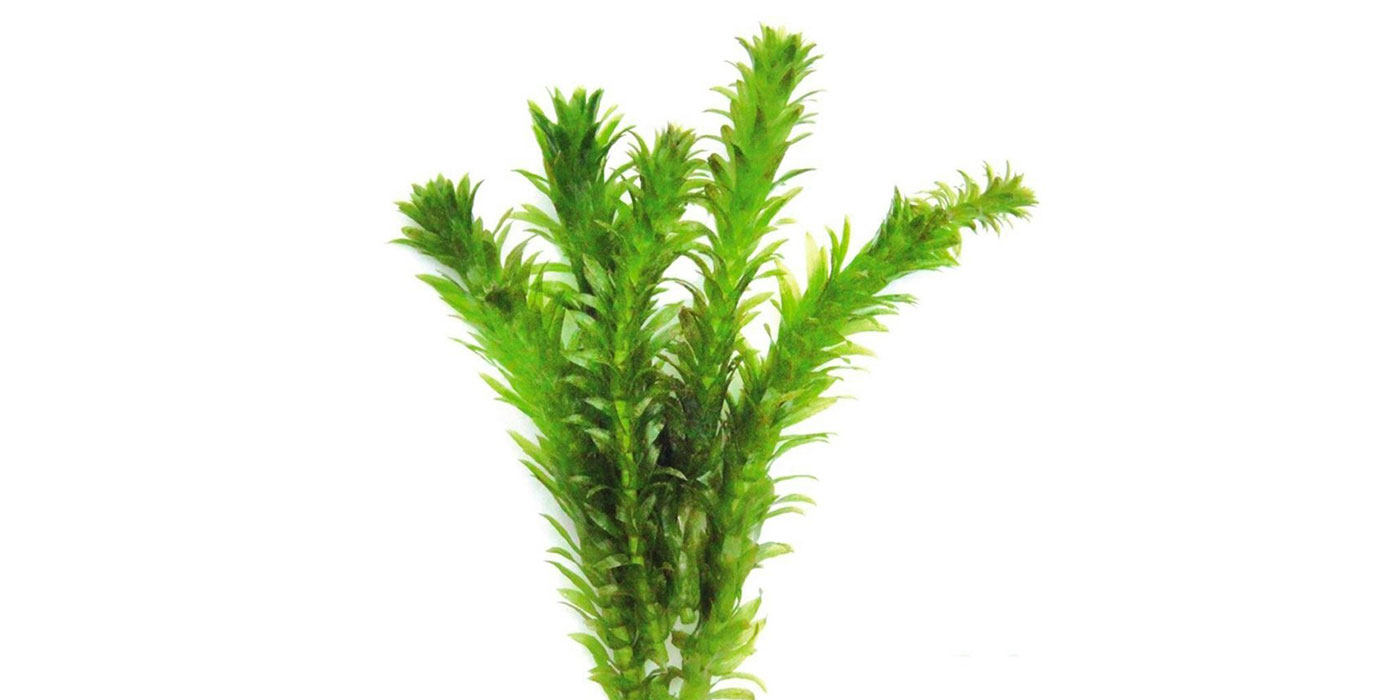
Common Name: Waterweeds
Scientific name: Elodea
Placement: Background
Like the Amazon Sword, Anacharis are great aquarium plants for beginners and are incredibly easy to maintain. Since the plant doesn’t actually have any roots or foot structure, it can be left floating around or anchored to a spot in the tank.
The anacharis also doesn’t require any special fertilizers or soils, and does well in low light conditions. It also propagates very easily by picking off a chute. They do best planted in groups and carry several secret maintenance weapons.
The plant helps prevent glue-green algae buildup by secreting a chemical to stop their spread. It also removes ammonia from the water and because of its quick growth rate, is a fantastic way to oxygenate tank water. Both of these are very important for a healthy betta fish. Anacharis offers plenty of dense cover for betta fish to hide amongst too.
3. Marimo Moss Ball
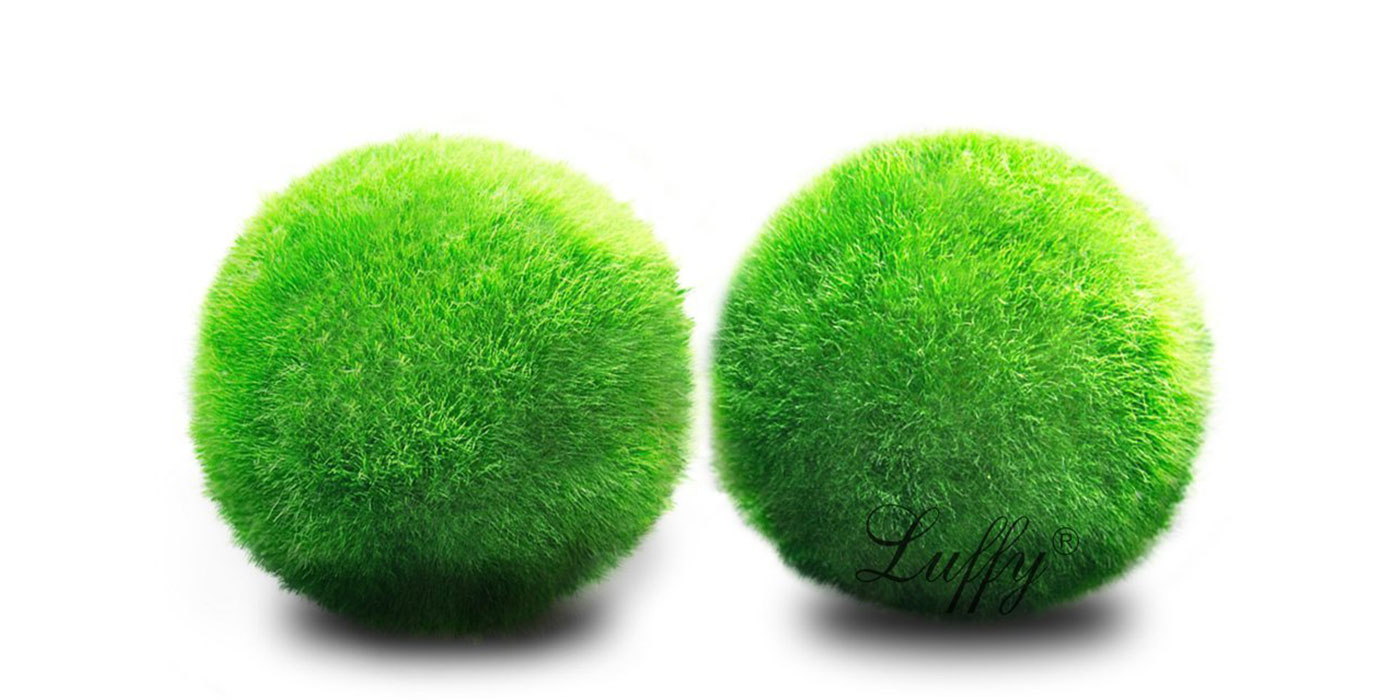
Common Name: Moss ball, Lake ball, Mossimo, Saweed ball
Scientific Name: Aegagropila linnaei / Chladophora aegagropila
Placement: Foreground
These fun little moss balls are fantastic for betta fish and tanks of all sizes. Did you know they can live for over 100 years!? Some people even keep them as pets of their own in terrariums.
They are ideal for betta fish because they absorb nitrates and act like natural filters, sucking up ammonia and other tank phosphates that are harmful to your betta. Marimo moss balls don’t require much light (low to medium and indirect), but do need to be rinsed and washed every so often.
Betta fish love these cute little moss balls for a bunch of reasons, but mainly because they can be rolled around, just like a toy or real ball. Betta can also nibble on them if they want to, rest on them, and hide around them. They are also a favorite of the ghost shrimp, an excellent candidate for a betta tank mate.
4. Java Fern & Java Moss
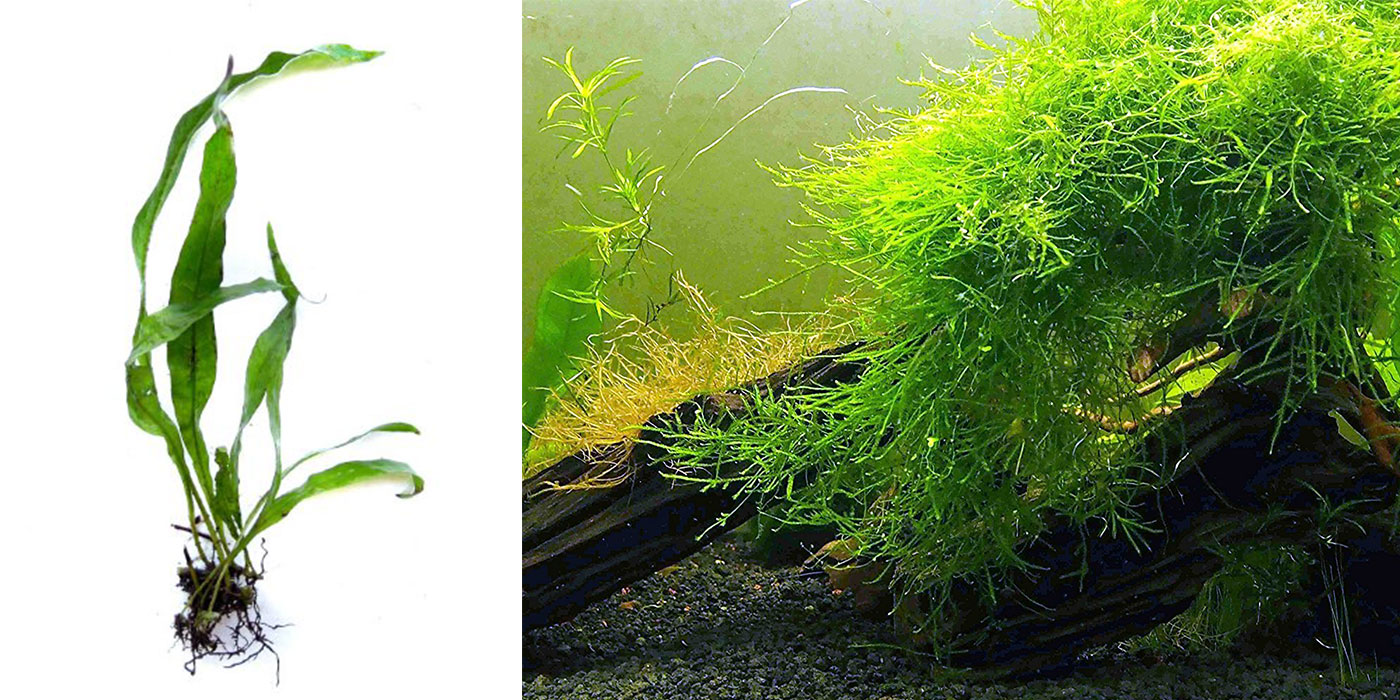
Scientific Names: Microsorum pteropus/Vesicularia dubyana
Placement: Mid-ground
Java ferns are capable of growing in a variety of environments and require little care (no fertilizer and low light) to do well in freshwater tanks. Additionally, java ferns don’t require soil or gravel, and can grow fully or partially submerged in tank water. Make sure to keep their rhizome exposed.
Java moss, much like the ferns, are incredibly forgiving when it comes to light (low to moderate) and water temperatures in the tank. Your betta fish however is not and should be kept at a constant tropical temperature with limited temperature fluctuations.
Java moss makes great carpeting on rocks and driftwood, and are a fan favorite amongst aquarists for it’s realistic ecosystem look. Both plants are easy to propagate too. Juvenile java ferns detach from the parent plant and float around before eventually attaching itself to another area of the tank. Java moss only needs to be divided to start growing a new plant.
5. Anubias
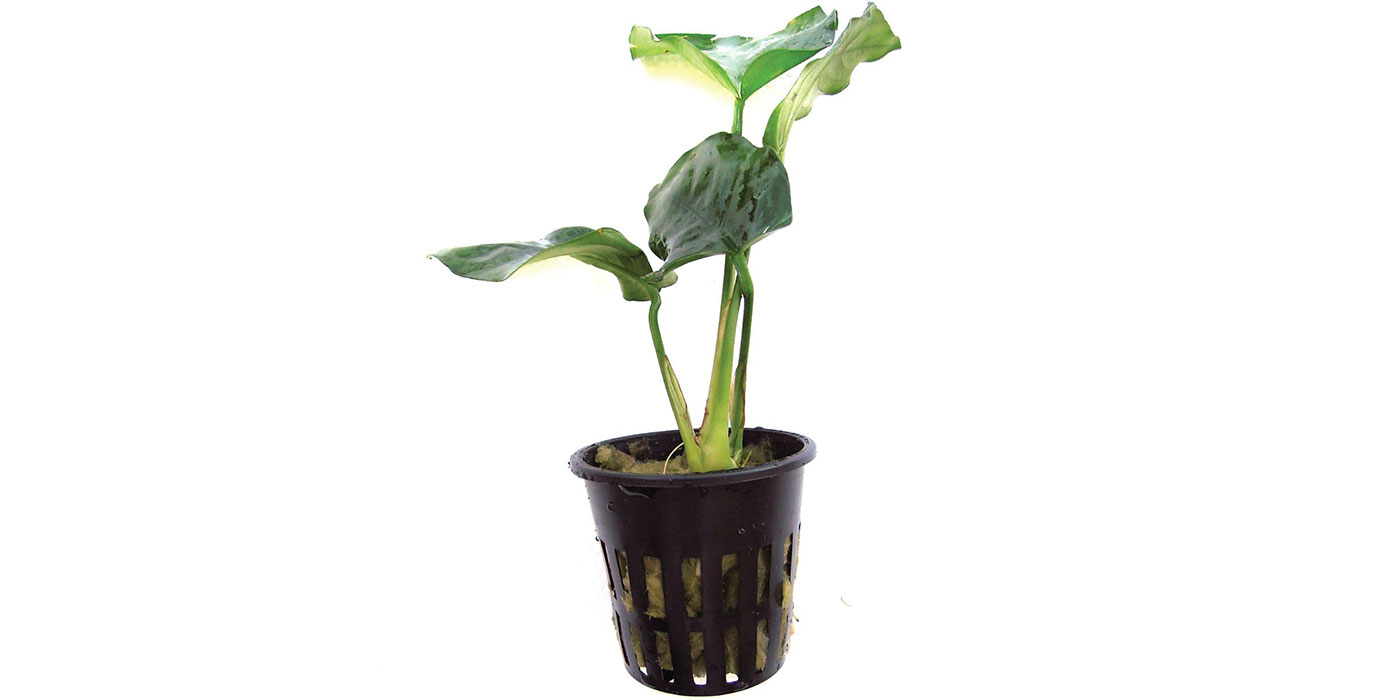
Common Name: Anubias nana
Scientific name: Anubias barteri
Placement: Foreground
Anubias is an easy to care for live plant that’s perfect for bettas. It’s able to grow in a variety of environments, and is capable of thriving in freshwater community tanks of any size. They prefer low light conditions and love clean tanks. Do not cover their rhizomes, thick portion above the roots or they will rot.
Anubias will grow anchored in aquarium gravel, floated, or attached to a decoration (e.g. driftwood) or rock. Fertilization is not required, but can support their health and growth rate. Anubias plants tend to grow slowly, and when they grow larger you can also propagate them into more individual plants in the same tank or others. They can also flower under water.
Because of their heavy, leather-ette leaves, Anubias are candidates for algae growth. To minimize the threat of algae, the plant should either be placed in an area where there is either water movement or underneath the shade of a larger plant. Adding an Anacharis in the tank isn’t a bad idea either, since it can help prevent algae growth.
6. Hornwort
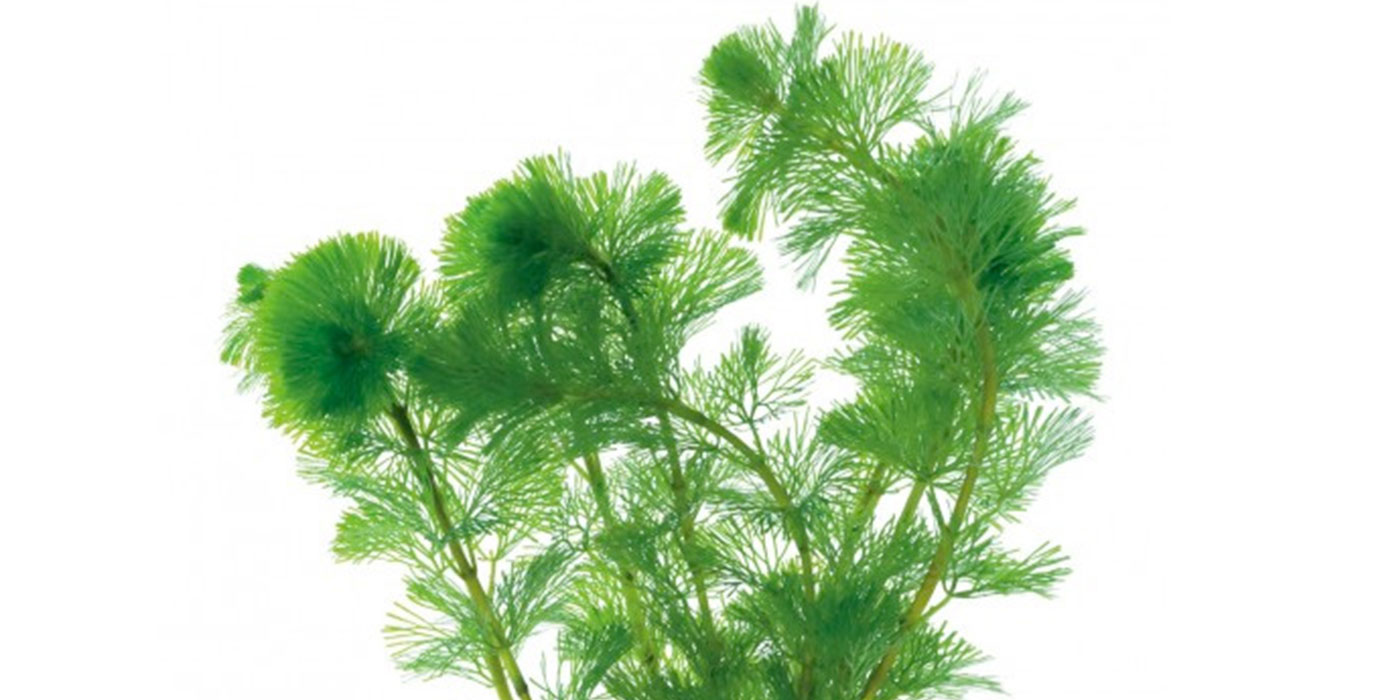
Common Name: Coontail
Scientific Name: Ceratophyllum demersum
Placement: Background
Another easy plant to care for and is a great live plant for betta fish owners. Known for its dark green leaves, this sturdy plant is excellent at oxygenating water and gobbling up ammonia. It can however be messy as it sheds its nettles which can rot and need to be siphoned out. It’s so good at removing nitrates that fertilizer is also recommended.
The hornwort grows quickly and forms great hiding spots for young fry to hide in and for adult bettas in community tanks. This live plant must be watched carefully to avoid a complete takeover of the tank because of its speedy growth. Hornwort also doesn’t have any roots, and thrives in low to moderate lighting.
Bettas tend to enjoy hornwort, but because of the high level of maintenance needed to keep the plant from taking over it’s best for those who have the time to keep up with the plants’ maintenance needs.
7. Hygrophila
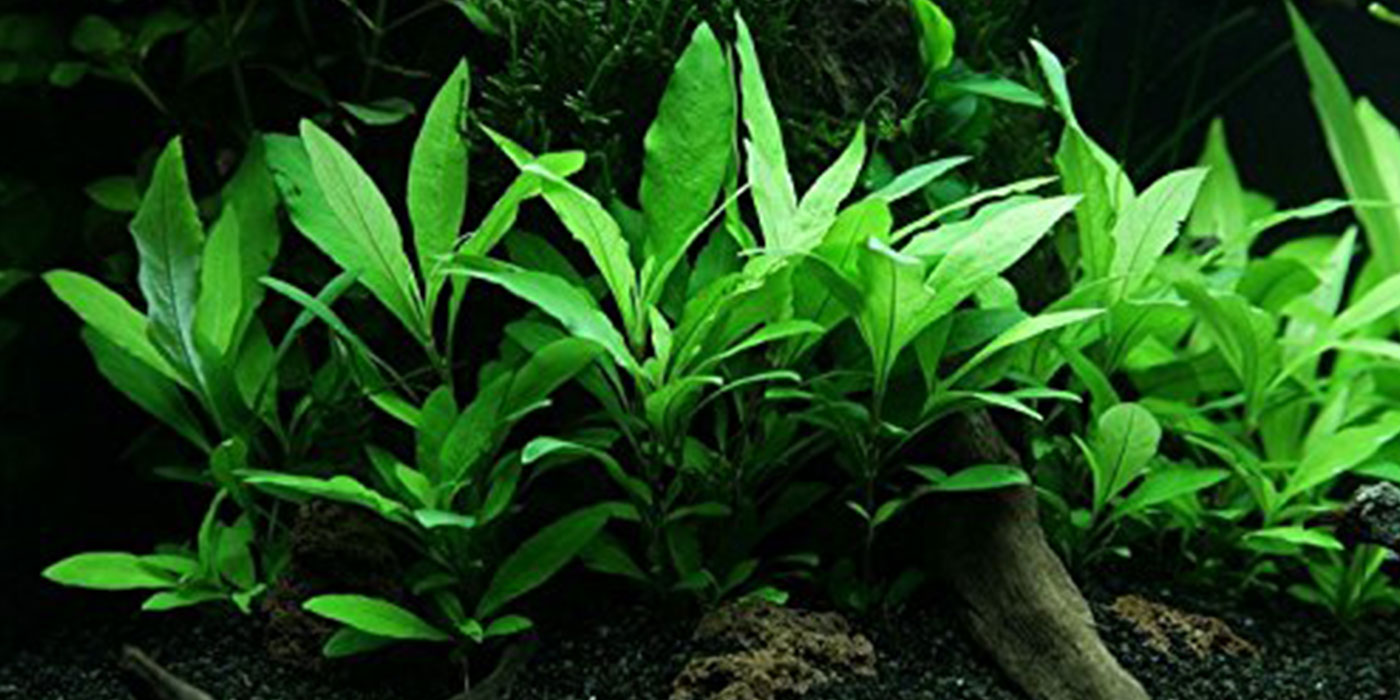
Common Name: Swampweeds
Scientific Name: Hygrophila corymbosa
Placement: Background
Hygrophila is moderately easy to maintain and makes for a great addition to betta tanks. It can grow up to 24 inches tall, and its dense green leaves serve as nice cover for tank equipment. Much like the Hornwort plant, Hygrophila will need to be monitored and trimmed to avoid a tank takeover.
The plant does need some nutrients, especially iron, to help it maintain a healthy and vibrant appearance which it can get from betta waste. They do well in low light conditions, fine substrate, and are easily propagated by trimming off a stem.
One of the biggest benefits of hygrophila for betta fish is that the plant grows incredibly well in conditions where betta fish also thrive. That means a happy plant likely means a very happy betta fish!
8. Wisteria
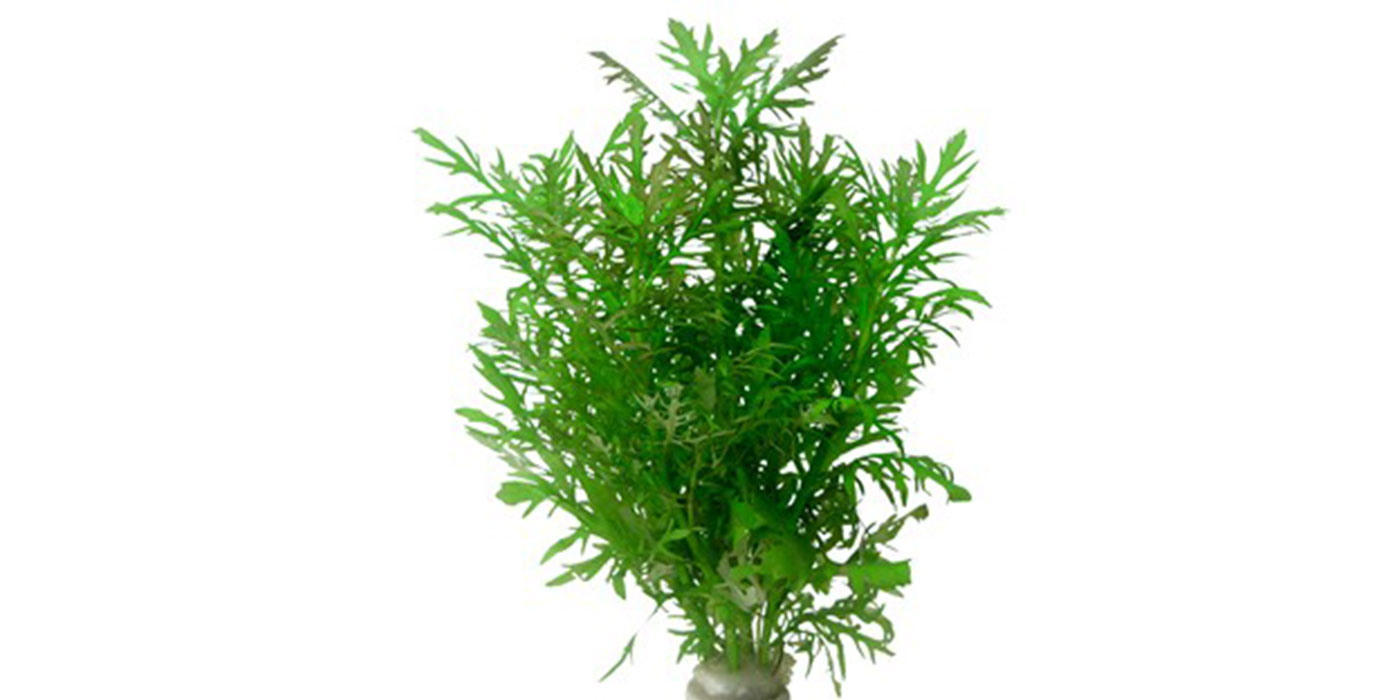
Common Name: Water Wisteria Plant
Scientific Name: Hygrophila difformis
Placement: Background or sides
The wisteria is a unique and undemanding aquarium plant that can live in low light conditions with occasional fertilizer. Depending on temperature and water conditions, the leaves will take on different shapes too.
Water wisteria is also a nice contrast plant as it doesn’t look like most other recommended plants and can provide complexity to your tank. It can be floated but thrives best when rooted. Betta fish love hiding amongst it too.
It is easily propagated with trimmings where roots will start growing out of exposed nodes. Because of its fast growth rate, frequent trimming is part of regular maintenance.
9. Vallisneria
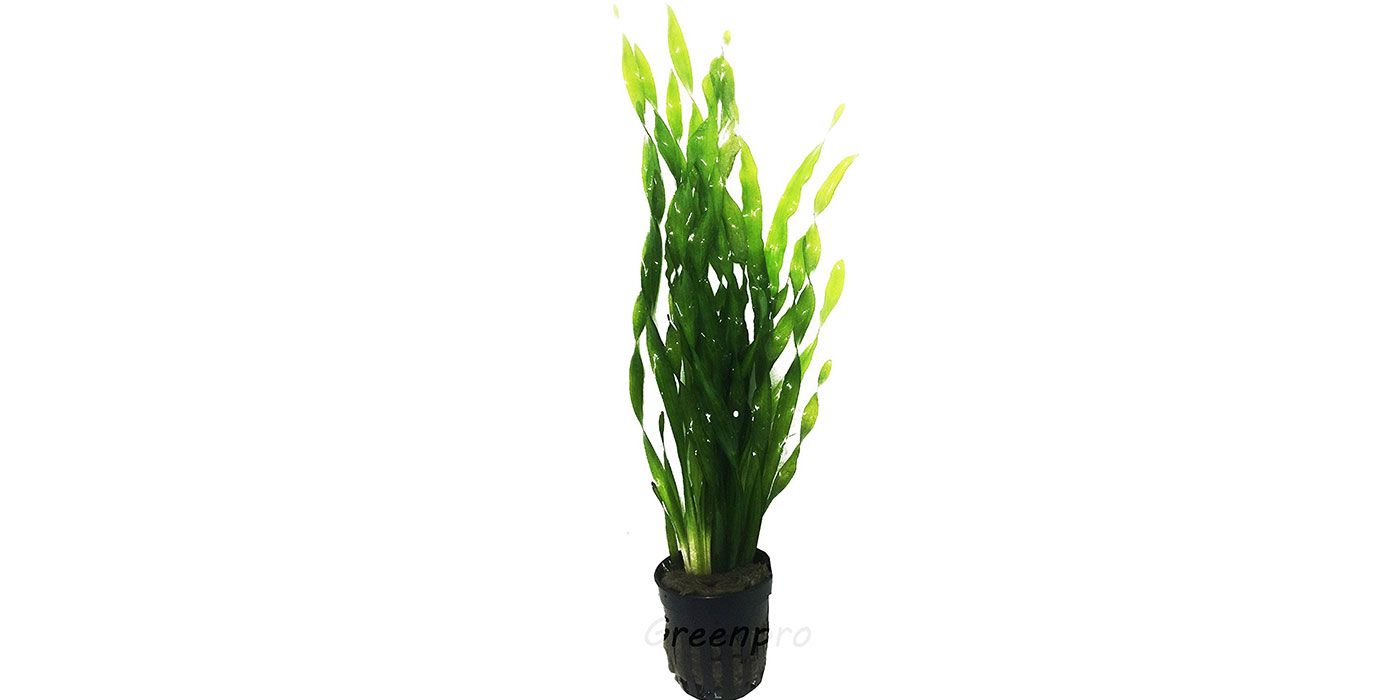
Common Name: Eelgrass, Tape grass, Vallis
Scientific Name: Vallisneria tortifolia/spiralis
Placement: Background or sides
This plant is another one of the easiest live plants to care for. It does best under moderate to high light conditions, however it will survive fine in low light too with slowed growth rates.
It grows quickly and produces ample hiding spaces that are perfect for betta fish. It’s a beautiful and flowing plant with dense leaf growths. One thing to be careful of is burying their roots too deep as that will hurt their health. Make sure to keep the crown exposed above the substrate.
Vallisneria propagates by sending out runners from the mother plant and if left unmonitored, can take over the tank and its waters’ surface. Remove runners or keep Vallis trimmed to maintain control.
10. Amazon Frogbit
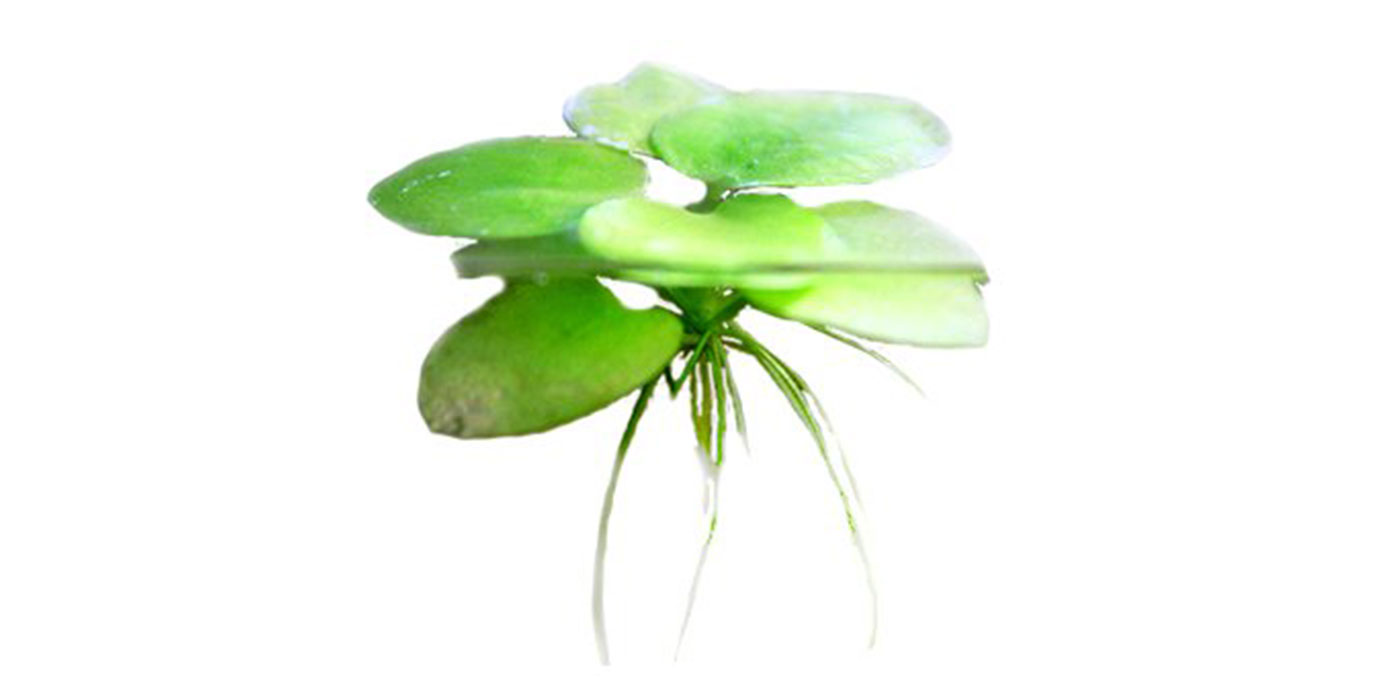
Common Name: West Indian spongeplant, South American spongeplant
Scientific Name: Limnobium Laevigatum
Placement: Surface
The Amazon Frogbit is great for betta fish because it helps make them feel safe under the shade and cover, and dense root growths they can hide amongst. It also adds some great flare and diversity to your tank.
If you’re planning to mate and breed betta fish, this plant is also great for protecting bubble nests and fry (babies). The Amazon Frogbit grows and multiplies fast! This is great because it’s easy to care for, but it also means you have to monitor its propagation.
Simply trim and remove excess growths during normal maintenance. This plant does best kept away from filters with the tops of their leafs staying dry. Limit its growth to allow light to pass to other plants below and allow for your betta to get to the surface for food and air.
Fake Plants, Live Plants and You!
The best plants for betta fish are those which provide ample cover, hiding places, and accommodate your skill level and time commitment. Live plants are highly recommended over fake because of their additional benefits, but only if you commit to their required maintenance. Choose the option that suits you best.
We recommend quarantining new live plants for 1-3 weeks in a separate tank before introducing them into your betta fish’s tank. This can reduce or eliminate the transfer of potential diseases and other bacteria. Transfer your betta to a hospital tank for medication treatment. A lot of medicines can damage or even kill your live plants. Not doing so could be a costly mistake.
Betta fish plants come in all shapes and sizes, colors and level of time commitment. If you have any other plant suggestions or questions, please submit a comment below!

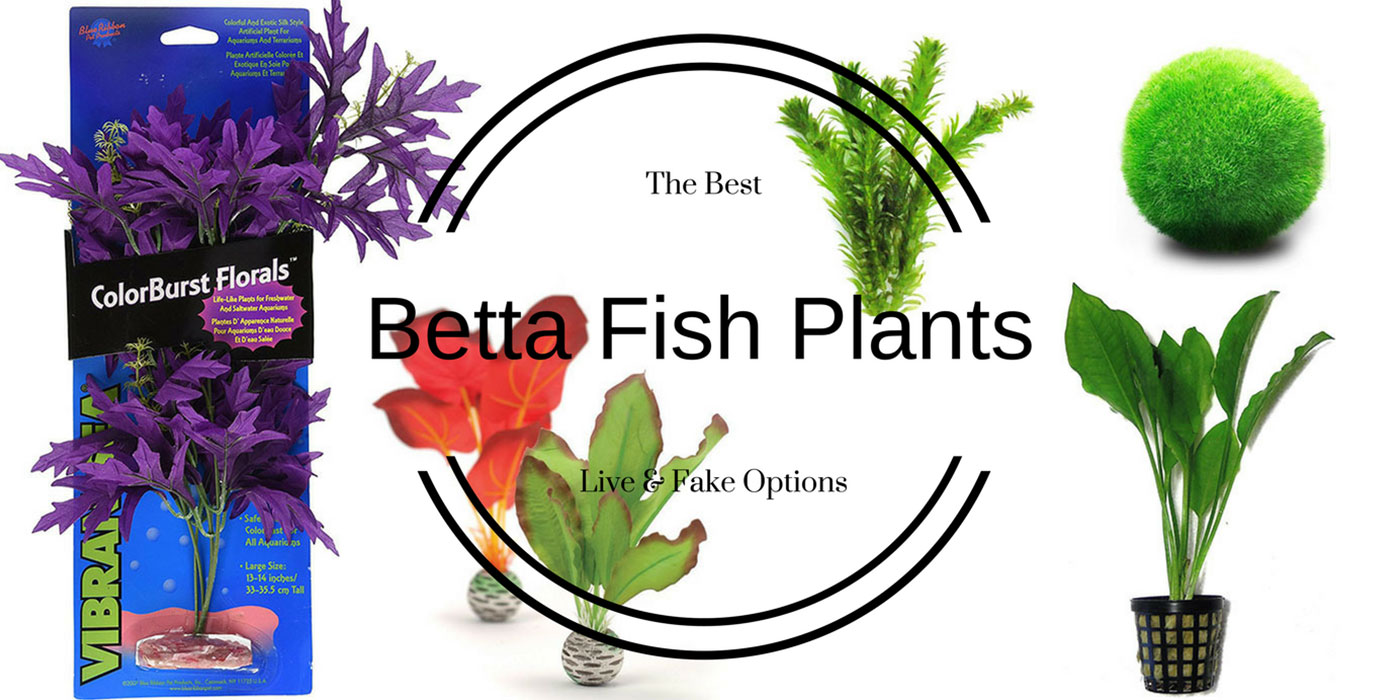

Why quarantine the plants? I am new at this, and I don’t understand what the purpose of putting them in a separate tank is. Are you observing them or just letting them soak and naturally remove potential contaminates?
Mainly, quarantining plants is necessary to avoid the transfer of snails, worms, pesticides, and parasites to name a few. Most pet stores and online sellers are good about not selling plants from inside community tanks but you just never know where they came from. That is unless you grow your own. Better safe than sorry right? That’s why some keepers just do a thorough tap water rinse, while others prefer to keep them in a separate tank for 1-2 days. You can also do a quick hydrogen peroxide dip – 1 part hydrogen peroxide to 5 parts water to clean them too before planting and that should be sufficient.
Excellent post! Thanks so much. I’m just learning how to set up a tank for the first time and your article was very helpful.
Thank you for the feedback, Jen! Hope everything goes well during setup 🙂
I bought my first betta fish yesterday. He’s a red&blue crown-tail I named Ripley. I want to put live plants in his tank, but need suggestions. I read the recommended plant article and the Anacharis and Marimo moss balls sound promising (looking for low light/low maintenance to start) would those be good choices for my crown-tail betta? Also, do you have online retailers you recommend (or don’t recommend)?
Thank You!
Try a Marimo moss ball! They can hide or play with it, unlike Anarchis, which is too heavy to be pushed around
My crown-tailed betta, Gandalf, LOVES his Marimo moss ball! I got mine at my local Petsmart!
I have a Marimo moss ball for my female Crown-tail betta
and have Java fern and some others that are not on here.
This is one of the most helpful guides I’ve seen on the subject. Thanks!
My hornwort started dying pretty much immediately in the stillwater lowlight betta tank, but in a higher light saltwater tank with water movement it’s doing okay. Is the hornwort doing badly in my betta tank because of the stillwater or the low light?
My hornwort almost died because I didn’t have any light but the natural daylight from a window nearby. When I added a daylight 6500 k bulb for six hours per day directly above the plant, it started growing again FAST. I have no filter in my 2.5-gallon tank and no salt.
Hi! I have an hydroponic tank for my little betta work buddy. I started out with a small peace lily (only roots submerged) that I purchased at the pet store and the peace lily did not make it. I have golden pothos that I was wanting to add to his tank. I have seen conflicting results with golden pothos d/t the toxicity level, but it will only the roots submerged as well. I was wondering if you had any thoughts. I have a marimo moss ball inside of the tank. I’m sad b/c my betta fish loved the roots to swim through and I just want to recreate that for him without causing him harm. He is cool little guy and I would be heartbroken if I killed him by adding a plant that was harmful. Any info would be helpful!
If there’s conflicting information, I wouldn’t risk it, Amy. There are other plants or fake silk plants where you can accomplish the same result even if it’s a DIY solution. Would you be able to use Amazon Frogbit as they have hanging down roots?
A long time ago I had a betta named V my mom got as a birthday gift from a friend. He came in a vase with a plant on top, she hates fish lol. So he became mine. After about six months I tried to switch him to a larger tank with silk plants and a bubbler filter. Within a day I could see he wasn’t happy and I added the plant back in by cutting a hole in the lid of the tank, and right back to being happy. My questions are these. A) Is this normal? B) How did he live for four years without a heater and a light? First fish ever…never knew.
The plant added a more realistic and natural habitat and also helped to clean the water and reduce things like ammonia. Ammonia can stress and eventually kill a betta. It’s possible to live that long without a heater and a filter if your house is warm, and if the plant was removing a lot of waste from the water, and lastly if he was a hardier tail-type like a veiltail.
Hi, I am new to your newsletter and I really enjoyed it! I had a Betta many years ago and he lived over a year and can’t believe he lived that long with me being so uneducated about what they need to survive and be healthy and happy! I’m so thankful for finding You! I am buying another wonderful beautiful Betta soon!
Hi! In a previous reply, you mentioned growing the plants yourself. I live outside the US and can’t order live plants because of import laws, and the selection of plants I’ve seen at pet shops here is limited and not what I’m looking for (betta-oriented, obviously). So yeah, I can’t import live plants, but I could import seeds, so is that what you meant by growing the plants yourself? And if so, do you know of any reputable online sellers of aquatic plant seeds? If that’s not what you meant, what method were you referring to? Thanks in advance!
Yes, that is what I meant Olivia. I only know reputable sources locally to me, but I’m sure with a little research you could find some decent options online that will ship to your location.
Thank you! I will be doing some research then.
Thank you for this information! I’ve had betta’s for a long time so I’ve been kind of knowledgeable on the subject in a general way. I refer back when I need to. Two years ago we started with a water fall beta tank (big mistake: The filter’s fall kept getting my betta’s fins stuck so eventually the filter went off) within the first year one of the betta’s passed away and I didn’t replace him. Last month my blue guy died really quickly… don’t know what it was but… all the stuff he was in and the tank is now gone. I have the red guy left… I have a YouTube channel with him on it. I said to myself… “this tank is not good for the betta’s …. I need to upgrade I don’t want red… fire… my betta dying too” Soon as I got the money I Got a 20 gallon… OMG is the fish happy. that was three weeks ago… It was one fish in there… the betta until this week…. I got six otto cats…. I figured Fire had claimed his territory…. so I got them in there…. Problem is that Fire ate some of the wafer I threw in… then he got constipated… yesterday noticed he was a little stressed… he was swimming with one fin pressed against his side…. Three days ago I added the cats…. I figured I’d do a water change…. he didn’t eat this morning. I did the change a little over an hour ago and this fish is swimming like there is no tomorrow…. lol The filter provides a current in the middle of the tank… I was thinking of getting a bubbler too but don’t know if that is over doing the oxygenation of the tank. The biggest thing this summer was I want to plant real plants which would probably make him even happier. THIS page is what I needed… will be ordering Wednesday 🙂 YouTube will get the updates 🙂 Thank you for your site!
Bettas need like barrels but they can have rough edges. It’s better to go with fake plants and moss balls.
There are a lot of rubber fake plants in stores now. Are they safe ? It says they are on package not sure. Thank you
I don’t believe I’ve encountered them yet myself. If they are listed as aquarium-safe then they should be okay. You’d still need to make sure they don’t have any sharp edges.
Do you have any tips for where the best place to buy aquarium safe driftwood is?
I would look on Amazon… or I’ve found great looking pieces at Petco.
Is lucky bamboo safe to plant in my 36 gallon tank with my betta?
Short answer, yes. I would, however, only allow the stalks to be submerged and the leaves to come out of the water if possible. I’ve had varying luck with lucky bamboo with the stalks decomposing after a while.
Great, thank you. I’m worried about Barry. Can I send you a video of him to get your opinion? I’m thinking velvet or fin rot.
Yes, of course.
Will aquarium salt kill live plants in the aquarium?
Depending on the type of plant and the amount of salt used, yes it can kill live plants. Some plants do better in brackish water than others.
I just got a dragon scale betta and I have him in a one gallon bowl. I would like to get him a tetra tank mate but I’m worried about the bowl being over crowded. I need some advise.
The bowl is too small for even a betta but could have silk or live plants. The minimum size recommended is 2.5-gallons and the water should be heated within 76-82 degrees fahrenheit. Tank mates are only recommended in 5-gallons or larger unless it’s a snail or live plants.
Hi Bryan,
I have a 10 gal fish tank and one Betta. I would like to add a Moss ball and/or Anacharis in it. Should I add one plant at a time? If so, how long should I wait between adding new plants?
Thank you
Mel
You can add more than one at a time. The moss ball will move around on the substrate of the tank and the Anarchis you will plant in the mid to back of the tank. Always rinse each new plant in hot hot tap water to help kill any bacteria or diseases that may be transferred.
Is bamboo okay to put in my betta’s tank?
Yes, you can place the roots/stalk of the bamboo in the tank but it often interferes with a tanks cover since it has to stick out the top. Rinse in hot tap water for a couple minutes to kill any bacteria before adding in should you decide to.
Hi this is my first time asking a question but, what about water lettuce? They are very similar to Frogbit and they hold their leaves above the waterline and live in the same type of environment, they keep their leaves dry and float on the surface with their roots hanging down. Would they work well in a Betta tank? Another advantage is that they spread slowly…
Yes, another great option for a betta tank. It does grow pretty fast though once it’s established.
Thanks for the help, Bryan!
I am planning on setting up a Betta tank soon and this article was very useful.
BTW, is it possible to have more than one Marimo Moss Ball in the same tank and have all of them be healthy?
You’re welcome, and yes of course they can. Just remember though, the more items you add to a tank the more it displaces to the total volume of water (a marimo does absorb water). Think of it like adding ice cubes to your glass. It starts to overflow because the object is taking up space in the tank. This is important because if your tank is 3-gallons and you add plants, gravel, decor, etc. you will start to decrease the total capacity of the water volume in the tank. A couple marimos would be fine though tanks on the smaller side.
I just got a betta fish and I tried growing a bamboo plant in with his tank but the water turned cloudy and now my parents won’t let me get any other live plants. Any recommendations on how I can convince them and/or what I should do when the tank water turns cloudy from the plants again?
Bamboo can be tough because it needs to extend out past the water surface and sometimes depending on its health the stalk can start to decay and cloud the water. An underwater plant recommended on this page will not make your water cloudy if it’s healthy and will help to oxygenate and keep the water cleaner.
I added live plants in my 2.5gallon aquarium (amazon swords, trident fern, guppy grass and a moss ball) and now my betta (named Drogon) looks stressed!! He’s always at the bottom at the gravel, not swimming around like before, and won’t eat! What do i do? Help! I’m stressed that he’s stressed!
I responded to your email.
Thank you!!!